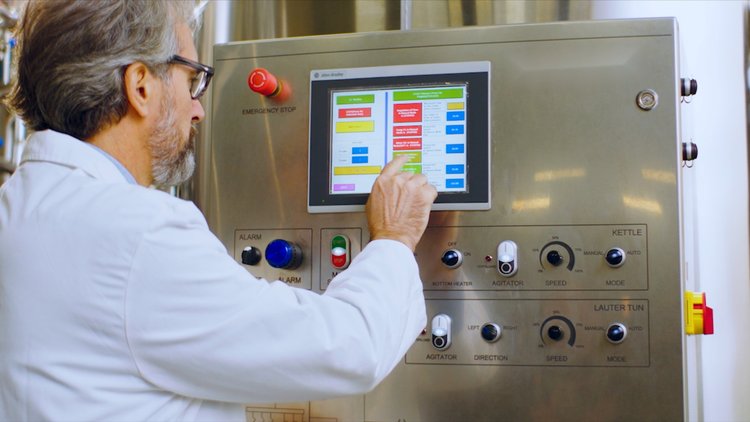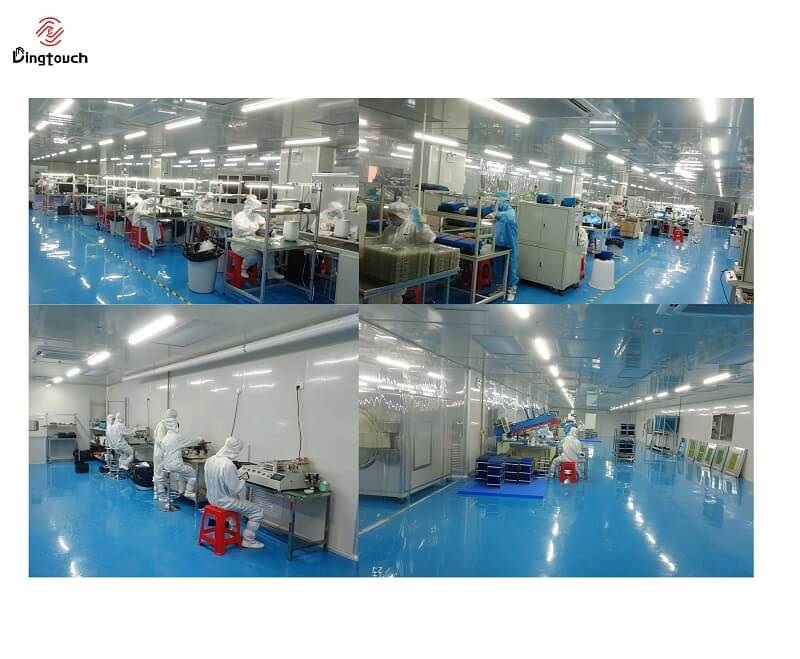News
In which industries are industrial displays used? Introduction to the application of industrial displays

In which industries are industrial displays used? Introduction to the application of industrial displays
With the rapid changes and innovations in traditional industrial control technology, touch display screens have important applications in industrial control and instrumentation. It can provide stable touch performance and reliability, adapt to industrial needs in harsh environments, and realize intelligent control of equipment.
Introduction to industrial displays
Industrial displays are displays used in industrial control processes or equipment. The main difference between it and civilian or commercial monitors is that the shell design generally adopts an all-steel design, and the panels are divided into different materials such as ordinary iron plates, stainless iron, stainless steel, and aluminum panels. The protection level of industrial monitors is expressed by IP**. The first digit is the dust-proof level, and the latter digit is the waterproof level. The dustproof rating is up to 6 and the waterproof rating is up to 8.
Industrial display classification
1. Open industrial display
Industrial monitors do not have face frame casing, only the interior. Most customers' applications are mainly in equipment and small size. They already have exquisite casings. There is not much space to install general displays, such as ATM machines, commercial POS, etc., which are generally installed on Internal to client equipment.
2. Embedded industrial display
As the name suggests, the embedded industrial display must be embedded into the customer's product. The customer's product must have a medium and large control cabinet. Our embedded industrial display only has the panel left, and the rest is embedded into the customer's equipment. Fix it with hooks (for large control cabinets, just open a large square hole according to the hole size in our embedded display installation diagram). No need to open any installation holes in other places.
3. Rack-mounted industrial display
Generally speaking, a rack-mounted industrial display is installed on a 19-inch cabinet, so its width is a standard 19 inches, and the mounting holes are opened according to the standard U number. Generally used in large cabinets such as telecommunications, electric power, and large servers.
4. Flip-chip industrial display
To put it simply, it is an industrial display that is installed in the customer's cabinet and equipment in reverse. It is installed inside the customer's machine equipment. The difference from the open industrial display is that it has a shell and a power supply, and its edges are in contact with the customer's machine. The shell edges overlap and are generally used in large and medium-sized equipment, such as power, machinery, and medical industries.
5. Wall-mounted industrial display
The special feature is that it can be hung, not just on the wall, but mostly installed on the customer's equipment. It can adjust the angle according to the customer's requirements, and with the appropriate mounting arm, it can stay in any position at will. For users to watch, generally used in small, medium and large equipment.
How to choose industrial touch monitor
1. First determine the product and project requirements, such as installation method, size, panel structure, signal type and LCD screen performance.
1. The installation methods are divided into rack type, flip-chip type, embedded type, open type and module.
Rack-mounted industrial monitors are used in industrial control cabinets, chassis and other equipment. The chassis is generally in U, and 1U is equivalent to 44CM. Commonly used are 4U, 6U, 8U, etc.
The flip-chip industrial display is installed from the back of the cabinet, and only the LCD display area is displayed on the front of the cabinet.
The embedded industrial display is embedded directly from the front of the cabinet and fixed with hooks on the side.
2. Size
Commonly used sizes of industrial monitors are 8.4 inches, 10.4 inches, 12.1 inches, 15 inches, 17 inches, 19 inches, and 21.5 inches. Some companies have also developed corresponding products for other sizes. First make sure the product uses an industrial display.
3. Panel structure
Panels are generally made of magnesium-aluminum alloy, cold-rolled steel plate, electro-galvanized plate, stainless steel plate, hot-dip galvanized plate, die-cast aluminum and other materials.
4. Signal type
The signal interface adopts VGA and AV interface.
5. LCD screen performance
Brightness: Since most flat-panel displays are used in indoor environments, the brightness is about 250~300cd/m2 (nits). LCDs with a diagonal size of 15 inches are the most commonly used. However, displays with this brightness level It cannot meet the requirements when used in an industrial environment. This is because the ambient light will be stronger and its brightness can easily exceed the brightness of the LCD backlight. Moreover, touch screens are often used in industrial environments, which also reduces the brightness of the display and makes it look darker. In common medical, industrial and public phone booth applications, the required brightness must reach at least 450 cd/m2.
Contrast: Unlike consumer displays, which are mainly used for direct viewing, for industrial-grade displays, users may not be viewing them at the optimal distance or under ideal lighting conditions, so a higher-contrast display is the best choice. For 10.4-inch, 12.1-inch or 15-inch monitors used in most industrial areas, a contrast ratio of 450:1 is ideal.
Color:
In some industrial applications, where specific color information is more important than text or numbers, it is important to measure the color as a percentage of NTSC color saturation. In LCD products, color saturation is completely dependent on the influence of backlight. CCF (cold cathode fluorescent screen) backlighting is a very popular technology and can achieve 70% and 80% of NTSC color saturation.
Perspective:
Commercial and consumer monitors are typically designed for use by a single person sitting directly in front of the monitor. In most industrial applications, this situation is very rare. For example, a physician or nurse cannot stop and look at the monitor directly during diagnosis and treatment. They just want to know the expected data. For large machines, operating directly in front of the monitor is simply impossible. For ship or aircraft navigation, it is inconvenient for the driver to sit directly in front of the LCD, especially when there are multiple displays, all of which face the viewer at different angles.
Monitors should have wide viewing angles, or be able to understand the displayed content at a glance. Consumer displays generally cannot meet such requirements. This is because they use twisted nematic technology (Twisted Nematic), so the viewing angles are limited. In order to better adapt to industrial applications, the display is required to have a wide viewing angle. Display technology with a viewing angle of up to 178° has been developed (such as ASV or MVA).
Backlight life
Cold cathode fluorescent (CCF) lamps are the most commonly used backlight source in LCDs. In industrial applications, the life of a CCF backlight is generally at least 50,000 hours, or the time the brightness drops to half compared to new. In many consumer applications, the time required for the backlight to drop to half its original brightness is only 10,000 hours.
Since consumer applications do not require continuous operation of the display, a CCF backlight life of 10,000 hours is sufficient. However, this is not the case in most industrial and medical applications. The life of the backlight is very low compared to the life of the LCD. Efforts are being made to double the life of backlights, but in most industrial applications a minimum life of 50 000 hours is considered the life standard for CCF backlights.
Industrial display application scope
1. Display for industrial site control;
2. Embed into various types of equipment as display devices;
3. Monitors for hosts in telecommunications and network computer rooms;
4. Monitoring displays in trains, subway stations and ports;
5. Vehicle-mounted (train, subway, car) displays;
6. Ruggedized or military-grade displays are generally used in harsh outdoor environments, military vehicles, and warships;
7. Advertising machines are used to play commercial advertisements in residential elevators, public places, commercial office buildings, etc.
More uses: Application fields in various industries such as telecommunications, electric power, multimedia, national defense, automation equipment, manufacturing and other fields. Lingshu is used as human-machine interface, thin client, PLC and POS and other communication and control terminals, digital hospital Make bedside service terminals and outpatient terminals to improve the service and management level of hospitals. Make media (advertising) players or query terminals in public places such as banks, shopping malls, hotels, train stations, buses, subway stations, parks, etc. Make homes in high-end residential areas. Service terminal realizes intercom, message, fee inquiry, product ordering, household appliance management, temperature and humidity control, etc.
D I N G T O U C H can provide more personalized touch display solutions based on the personalized needs of your product application scenarios.
![]() Email: sales@szdingtouch.com
Email: sales@szdingtouch.com
![]() Skype: +8615815536116
Skype: +8615815536116
![]() Phone No.: +8615815536116
Phone No.: +8615815536116
CATEGORIES
CONTACT US
Contact: Dingtouch
Phone: +8615815536116
Tel: +8615815536116
Email: sales@szdingtouch.com
Add: Building A, Bailu Plaza, No. 48, Gonghe Industrial Road, Gongle Community, Xixiang Street, Baoan District, Shenzhen,China. 518126

 Dingtouch
Dingtouch